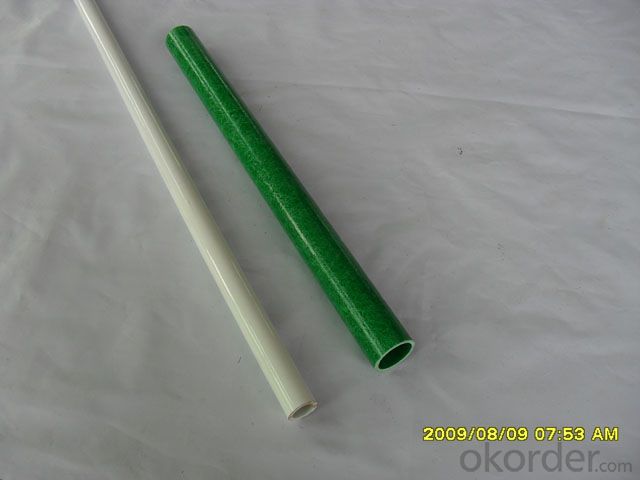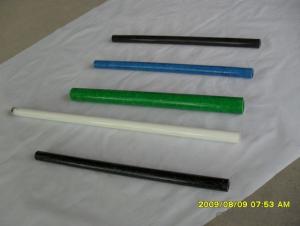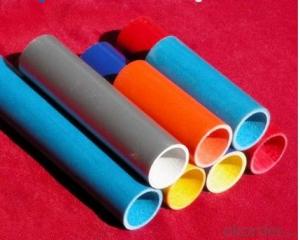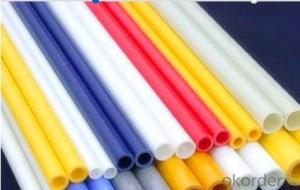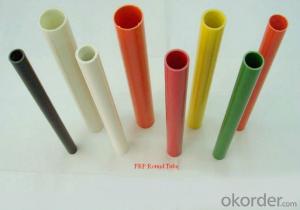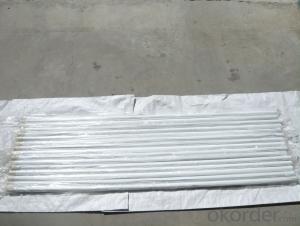FRP Pultrusion Profiles Durable Fiberglass Tool Handle
- Loading Port:
- China Main Port
- Payment Terms:
- TT OR LC
- Min Order Qty:
- -
- Supply Capability:
- -
OKorder Service Pledge
OKorder Financial Service
You Might Also Like
Specifications of Pultruded Durable Fiberglass Tool Handle:
1) Pass ISO9001
2) 25mm 28mm 32mm 35mm 38mm
3) 1'' 1.108'' 1.25'' 1.38'' 1.50''
4) UV protection
5) Competitive price
Features of Pultruded Durable Fiberglass Tool Handle:
1) Fiberglass tool handles are designed for a variety of implements including shovels, rakes, hoes, pruners and post hole diggers.
2) Diameter: 25mm 28mm 32mm 35mm 38mm 1'' 1.108'' 1.25'' 1.38'' 1.50''
3) Color: red, black, white, yellow, blue, green, gray
4) Fiberglass tool handles may be produced cut-to-length or in stock-length quantities determined by the customer
5)Lightweight, High Impact Resistant, Low Conductivity, Corrosion Resistant, Durable/Weather Resistant Surface, Aesthetic Appeal
6)The fiberglass tool handles will not splinter or break under normal conditions and are extremely strong and long-lasting. Strongwell tubes are manufactured with surfacing veils unless otherwise specified.
- Q: Are FRP pultrusion profiles resistant to seismic activity?
- Yes, FRP pultrusion profiles are generally resistant to seismic activity. Due to their high strength-to-weight ratio and excellent flexibility, FRP profiles have demonstrated great resilience and durability during seismic events. Additionally, their non-corrosive nature and superior fatigue resistance make them suitable for seismic-prone regions. However, specific design considerations and engineering analysis are necessary to ensure optimal performance in seismic conditions.
- Q: How do FRP pultrusion profiles handle cyclic loading?
- FRP pultrusion profiles are known for their excellent performance under cyclic loading conditions. The unique combination of materials and manufacturing process used in pultrusion makes these profiles highly resistant to fatigue and cyclic loading effects. One key factor that contributes to the superior performance of FRP pultrusion profiles under cyclic loading is their inherent high strength-to-weight ratio. These profiles are made using continuous fibers, typically fiberglass, which are impregnated with a resin matrix. This results in a lightweight yet strong material that can handle repeated loading without experiencing significant degradation or fatigue. Additionally, the pultrusion process allows for precise control over the fiber orientation and resin distribution within the profile. This results in a uniform and consistent material composition throughout the entire length of the profile. As a result, FRP pultrusion profiles exhibit excellent load distribution characteristics, minimizing stress concentrations and preventing localized failure under cyclic loading conditions. Furthermore, the corrosion resistance of FRP pultrusion profiles plays a crucial role in their ability to handle cyclic loading. Unlike traditional materials such as steel, FRP profiles do not suffer from corrosion-related issues, such as rust or pitting. This corrosion resistance ensures that the profiles maintain their structural integrity even when subjected to cyclic loading over extended periods of time. Overall, FRP pultrusion profiles are specifically designed and manufactured to withstand cyclic loading conditions. Their high strength-to-weight ratio, uniform material composition, and corrosion resistance make them ideal for applications where cyclic loading is a significant factor. Whether it's in structural reinforcements, bridges, sporting equipment, or various industrial applications, FRP pultrusion profiles have proven to be reliable and durable under cyclic loading.
- Q: What are the different types of FRP pultrusion profiles available?
- Some of the different types of FRP pultrusion profiles available include standard shapes such as I-beams, channels, angles, and tubes. Additionally, there are custom profiles that can be designed and manufactured based on specific project requirements.
- Q: What are the maintenance requirements for FRP pultrusion profiles?
- FRP pultrusion profiles have low maintenance requirements due to their durability and resistance to corrosion. They are a low-maintenance choice for various applications. However, there are a few important maintenance practices that can help prolong their lifespan and ensure optimal performance. Firstly, it is important to periodically clean the profiles to remove dirt, dust, and debris. This can be achieved by using a mild detergent solution and a soft brush or cloth. It is advisable to avoid abrasive cleaners or materials that could scratch the surface. Regular visual inspections should also be conducted to identify any signs of damage or wear. Cracks, chips, delamination, or any other visible defects should be promptly addressed to prevent further damage. While FRP pultrusion profiles are generally resistant to UV radiation, prolonged exposure to direct sunlight can cause some degradation. Applying a UV protective coating or using a UV-resistant paint can minimize the effects of UV exposure and extend the profiles' lifespan. For pultrusion profiles with moving parts or connections, such as hinges or joints, it is important to apply a suitable lubricant to ensure smooth operation and prevent friction-related issues. It is crucial to use lubricants compatible with FRP materials to avoid any adverse chemical reactions. In the event of significant damage or wear, it may be necessary to repair or replace the affected sections of the FRP pultrusion profiles. Trained professionals with experience working with FRP materials should perform this task to ensure proper repair techniques and maintain structural integrity. In conclusion, while FRP pultrusion profiles require minimal maintenance, regular cleaning, inspection, and prompt addressing of issues are crucial for their longevity and optimal performance. By following these maintenance practices, the lifespan of FRP pultrusion profiles can be maximized while maintaining their structural integrity over time.
- Q: Can FRP pultrusion profiles be used in the construction of wastewater treatment tanks?
- Yes, FRP (Fiber Reinforced Plastic) pultrusion profiles can be used in the construction of wastewater treatment tanks. FRP materials are highly resistant to corrosion, making them suitable for harsh environments such as wastewater treatment facilities. Additionally, FRP pultrusion profiles offer high strength-to-weight ratio, durability, and low maintenance requirements, making them an ideal choice for constructing wastewater treatment tanks.
- Q: Can FRP pultrusion profiles be used in mining applications?
- Mining applications can utilize FRP pultrusion profiles, which are known for their high strength-to-weight ratio, durability, and corrosion resistance. These profiles are suitable for a range of purposes in mining operations. They can provide structural support in underground mines, including the construction of tunnels, shafts, and mine roofs. Their strength allows them to handle heavy loads and provide long-term support. Additionally, FRP pultrusion profiles can support equipment and machinery like conveyor systems, pumps, and tanks. Their corrosion resistance makes them ideal for use in harsh mining environments that involve exposure to moisture, chemicals, and abrasive materials. Moreover, FRP pultrusion profiles can be used for safety applications in mining, such as handrails, walkways, and grating systems. These profiles offer reliable and non-slip surfaces, ensuring the safety of mining workers. In summary, FRP pultrusion profiles bring several advantages to mining applications, including high strength, corrosion resistance, durability, and easy installation. These qualities make them a cost-effective and viable option for various mining operations, enhancing efficiency and safety in the industry.
- Q: Can FRP pultrusion profiles be used in infrastructure projects?
- Yes, FRP (Fiber Reinforced Polymer) pultrusion profiles can be used in infrastructure projects. FRP pultrusion profiles offer several advantages over traditional materials such as steel and concrete. Firstly, FRP profiles are lightweight, yet still possess high strength-to-weight ratios. This makes them easier to transport and install, reducing construction time and costs. Additionally, their lightweight nature ensures they do not exert excessive loads on the supporting structures. Secondly, FRP profiles are corrosion-resistant. Unlike steel, FRP does not rust or corrode when exposed to harsh environmental conditions, making them ideal for infrastructure projects located in coastal areas or regions with high humidity. This corrosion resistance extends the service life of the structures and reduces maintenance requirements, resulting in long-term cost savings. Thirdly, FRP pultrusion profiles offer excellent durability and dimensional stability. They are highly resistant to fatigue, creep, and environmental degradation, ensuring the longevity and structural integrity of the infrastructure. Their dimensional stability also means that they maintain their shape and structural properties over time, reducing the risk of deformation or failure. Furthermore, FRP profiles can be customized to meet specific project requirements. They can be manufactured in various shapes, sizes, and strengths, allowing for versatile applications in infrastructure projects such as bridges, walkways, railings, support structures, and utility poles. Overall, the use of FRP pultrusion profiles in infrastructure projects offers numerous advantages, including lightweight construction, corrosion resistance, durability, and customization options. These benefits make FRP profiles a viable and cost-effective alternative to traditional materials for various infrastructure applications.
- Q: How do FRP pultrusion profiles perform in chemical processing plants?
- Due to their outstanding performance in challenging environments, FRP pultrusion profiles are extensively utilized in chemical processing plants. Specifically engineered to endure the harsh conditions prevalent in such facilities, these profiles are favored over traditional materials like steel or concrete. One key benefit of FRP pultrusion profiles in chemical processing plants lies in their remarkable resistance to corrosion. These profiles exhibit a high level of resistance to a diverse range of chemicals, including acids, alkalis, solvents, and highly corrosive substances. This resistance ensures the profiles' durability and integrity even in aggressive chemical environments, subsequently decreasing maintenance costs and prolonging equipment service life. Moreover, FRP pultrusion profiles boast exceptional mechanical properties, such as a high strength-to-weight ratio. This enables them to bear heavy loads without compromising their structural integrity. Additionally, their lightweight nature facilitates easier handling and installation, thereby reducing labor and transportation expenses. Furthermore, FRP pultrusion profiles possess excellent electrical insulation properties, making them ideal for applications that require minimal electrical conductivity. This eliminates the risk of electrochemical reactions and ensures the safety of both personnel and equipment. Another advantage of FRP pultrusion profiles is their ability to provide effective thermal insulation. They effectively minimize heat transfer, thereby reducing energy loss and enhancing energy efficiency within chemical processing plants. Additionally, FRP pultrusion profiles are non-magnetic, making them advantageous in certain applications where magnetic interference could disrupt sensitive equipment or processes. In summary, FRP pultrusion profiles offer exceptional corrosion resistance, mechanical strength, electrical insulation, thermal insulation, and non-magnetic properties, making them exceedingly suitable for chemical processing plants. These profiles provide a cost-effective and long-lasting solution that can endure the demanding conditions encountered in chemical processing environments, ensuring reliable performance and reduced maintenance requirements.
- Q: Can FRP pultrusion profiles be used in the oil and gas industry?
- Yes, the oil and gas industry can utilize FRP (Fiber Reinforced Polymer) pultrusion profiles. These profiles offer numerous advantages that make them suitable for use in this sector. To begin with, FRP pultrusion profiles exhibit corrosion resistance. They remain unaffected by harsh conditions such as saltwater, chemicals, and extreme temperatures, thereby avoiding rusting, corrosion, or degradation. Consequently, they prove ideal for offshore platforms, pipelines, and other oil and gas facilities where corrosion poses a significant problem. Moreover, FRP pultrusion profiles possess a high strength-to-weight ratio. Despite being lightweight, they possess remarkable strength, enabling efficient installation, transportation, and handling. This aspect is especially advantageous in the oil and gas industry, where reducing weight is crucial for enhancing operational efficiency and decreasing costs. Additionally, FRP pultrusion profiles can be customized to meet specific requirements. They can be manufactured in various shapes, sizes, and configurations, making them adaptable for diverse applications within the oil and gas industry. Whether it be for structural supports, grating, handrails, or other components, FRP pultrusion profiles can be tailored to perfectly suit the distinct needs of each project. Furthermore, FRP pultrusion profiles offer exceptional electrical insulation properties. This attribute holds immense importance in the oil and gas industry, where electrical safety is of utmost priority. By providing insulation and preventing electrical conductivity, FRP profiles reduce the risk of accidents and ensure the safety of both personnel and equipment. In conclusion, FRP pultrusion profiles have demonstrated their reliability, durability, and cost-effectiveness across various applications within the oil and gas industry. Their resistance to corrosion, high strength-to-weight ratio, customization capabilities, and electrical insulation properties make them an appealing choice for this demanding sector.
- Q: Can FRP pultrusion profiles be used in the construction of oil storage tanks?
- FRP pultrusion profiles are a viable option for constructing oil storage tanks due to their numerous benefits. Firstly, the corrosion resistance of FRP is crucial in this application as it ensures the durability of the tanks under harsh environmental conditions and the corrosive properties of oil. Unlike steel, which requires regular maintenance and is prone to corrosion, FRP pultrusion profiles provide a suitable alternative. Moreover, the lightweight nature of FRP pultrusion profiles simplifies their handling and installation compared to heavy steel components. This not only reduces construction time but also cuts down on costs, making FRP an appealing choice for oil storage tank construction. Additionally, FRP pultrusion profiles offer exceptional strength and durability, ensuring the structural integrity of the tanks. The material's impressive strength-to-weight ratio enables efficient load-bearing and structural performance. Furthermore, engineers can customize FRP pultrusion profiles to meet specific design requirements, allowing for flexibility in tank design and construction. The pultrusion process allows for the production of intricate shapes and sizes, enabling engineers to optimize the tank's design for maximum efficiency. Lastly, FRP is non-conductive and possesses high electrical resistance, making it a safe option for oil storage tanks. This eliminates the risk of electrical hazards that may arise in tanks constructed with conductive materials. In conclusion, FRP pultrusion profiles offer a myriad of advantages for constructing oil storage tanks, including corrosion resistance, lightweight construction, high strength, design flexibility, and electrical safety.
Send your message to us
FRP Pultrusion Profiles Durable Fiberglass Tool Handle
- Loading Port:
- China Main Port
- Payment Terms:
- TT OR LC
- Min Order Qty:
- -
- Supply Capability:
- -
OKorder Service Pledge
OKorder Financial Service
Similar products
Hot products
Hot Searches
Related keywords



